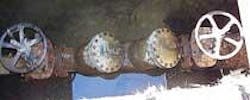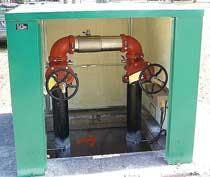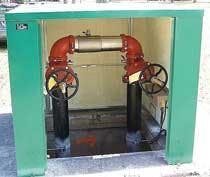Vault Replacement Project Moves Backflow Preventers Above Ground
by Mike Devine
The Firefighters Equipment Co. of Jacksonville, FL, recently completed a vault retrofit project in Gainesville, FL, replacing 15 old vault-installed backflow prevention assemblies with new valves installed above grade.
The backflow vaults being replaced were flooded, the valves were rusted and piping was covered with mud. This is a common condition when dealing with older piping systems in underground vaults. It illustrates why many utilities and design engineers today specify above ground installation for valves, meters and equipment.
Rick Hicks of Firefighters Equipment and his crew planned the project for a minimum of down time for the facilities involved. They selected replacement backflow assemblies with shorter lay lengths so that the new assemblies, including 90-degree fittings for the risers, would fit up through the existing vault access hole at grade level. By using the existing access hole and vault concrete roof, they saved the time and expense of cutting concrete and pouring new pads.
They also prefabricated the fittings and riser pipes in advance, so they could simply slip them into place during installation with limited water shut-off down time.
Hicks ordered protective enclosures in advance so his crew would have the enclosures on site, ready to mount the same day they installed the valves. Care was taken in dimensioning the enclosures so that they fit around the new valves, gave access for testing and maintenance and also fit on the existing slab for anchoring purposes.
The protective enclosures, supplied by HotBox, were fabricated from aluminum and internally insulated with structural foam. Access doors were strategically placed in the enclosures to allow for valve testing and maintenance access. Backflow prevention assemblies are typically required by the local water purveyor to tested and certified annually, so access into the enclosure is a concern. Naturally, the enclosures provided means of anchor to the concrete slab and lockable access doors. For this particular project, the facility owner requested color coded enclosures to match the existing color scheme of the buildings on the campus property.
By prefabricating the enclosures and having them on site during valve installations, the crew left no open access holes exposed (fall hazard) at any time during the project.
Background
Large backflow prevention assemblies, particularly on fire sprinkler supply lines, are sometimes installed in an underground vault. This can cause difficulty and extra expense for the property owner.
Backflow prevention devices are not designed for submersion. Even properly designed underground vaults, those with "daylight drains", occasionally flood. Vaults without drains flood all the time. Even with double check valves, many pits over time simply fill up with water (rain or water table intrusion), mud, sludge or animals (live or dead), creating conditions that are not suitable for water supply equipment.
Besides flooding, confined space entry is always a concern with a vault. Vaults can be dangerous and expensive places to work, increasing the cost of maintenance and testing. In addition, limited lighting and lack of access to various work tools and equipment mandate more logged time for maintenance personnel.
Typical Concerns
The Gainesville project illustrates some of the typical concerns when providing cross connection control and installing backflow protection above ground such as:
– Final elevation of the assembly. Local and national codes need to be observed. Generally, a backflow prevention assembly is required to be mounted with assembly bottom no less than 12" above the finished grade. However some areas are different. For example, New York State requires that backflow prevention assemblies be installed with a valve centerline 30" above the finished grade. Also, the enclosure needs to be tall enough to accommodate the valve inside, but not so tall as to be obtrusive or provide "wasted space."
– Proximity to other physical boundaries is important. The valve and enclosure installation need to be "accessible" for testing and maintenance. Enclosure doors need to be able to swing free, technicians need to be able to enter into the enclosure to work on the valve assembly with tools and equipment. Care needs to be taken to consider utility easement access, whether obvious or not to the installer.
– In cold climates riser sleeves should be installed to allow for pipe expansion/ contraction and for warm air transfer from inside the heated enclosure to the pipe risers so they do not freeze.
– Electrical power for heaters, alarms or lights should be installed prior to pouring the slab. Also. Communication wiring, if required, needs to be installed prior to the slab.
Protective enclosures finish the project, providing security, climate protection and aesthetic appeal. ASSE # 1060 certified enclosures provide protection meeting at least minimum requirements for material construction, load testing, drainage, testing access and freeze protection.
Conclusion
Firefighters Equipment Company's management of this project provides an excellent example of planning and execution. Their efforts resulted in a project on time, in budget, and a satisfied customer that had no safety concerns during construction and no operational concerns since completion of the project.
About the Author:
Mike Devine has been a business owner in Florida since 1977. He started Hot Box® Enclosures in 1986 and built it into the industry leader in enclosures for water pumps and valves, receiving several patents and numerous registered trademarks before he sold the business to CDR Systems Group in 2004. Mr. Devine was also instrumental in working with ASSE to establish a national Standard for backflow enclosures.



